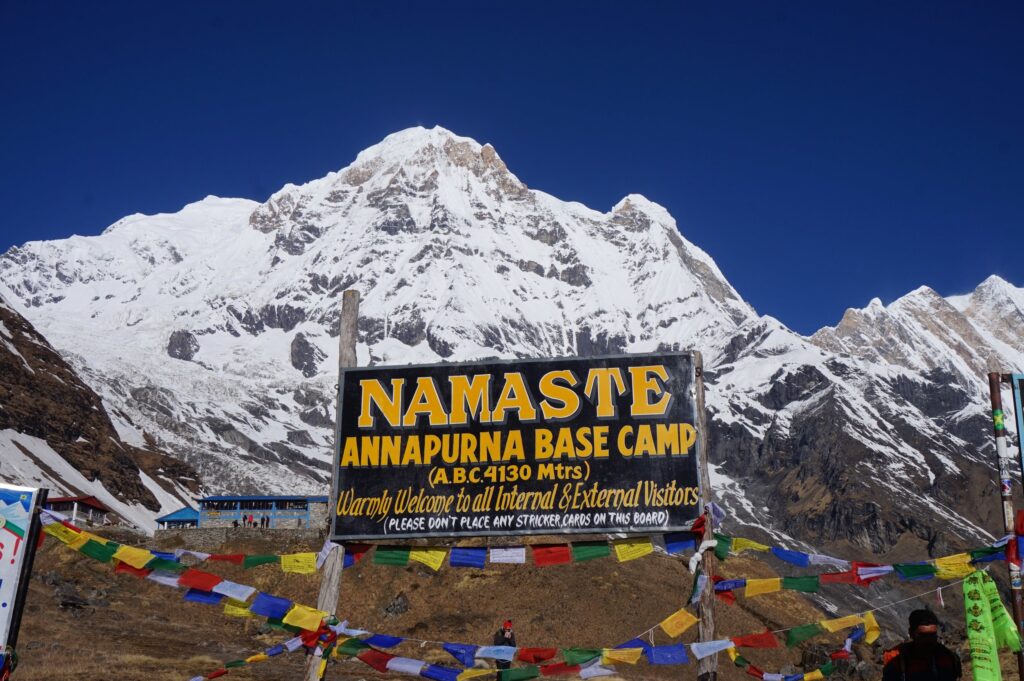
Trekking to Annapurna Base Camp (ABC) is one of the most popular and breathtaking adventures in Nepal. The route takes you through diverse landscapes from terraced farmlands and rhododendron forests to glacier- covered peaks and reaches elevations of over 4,100 meters. To fully enjoy the experience, packing smartly is essential. Having the right gear can mean the difference between a comfortable journey and a challenging one.
Your gear should begin with a well-fitted backpack, ideally around 40 to 50 liters, that can carry your daily essentials. If you’re hiring a porter, bring a duffel bag for them to carry, and keep a small daypack (15 to 25 liters) with you for water, snacks, and valuables. Since, the weather in the Himalayas can be unpredictable and temperatures vary greatly with altitude, layering is key. Start with moisture-wicking base layers both shirts and thermal tops and bottoms. Over that, add an insulating fleece and a warm down or synthetic jacket. A waterproof and windproof outer shell is a must, especially in case of rain or snow.
First thing to Pack in Annapurna Base Camp, you’ll need two or three pairs of lightweight trekking pants, one of which can convert to shorts or be worn in warmer lower altitudes. Don’t forget several pairs of moisture-wicking socks and underwear. A warm hat, gloves (preferably a pair of thin liners and thicker insulating gloves), and a neck gaiter or buff will help protect you from the cold and wind at higher elevations. A wide-brim hat or cap is useful in the lower, sunnier regions.
Footwear is critical. Well-broken-in, waterproof trekking boots are non-negotiable. Camp shoes or sandals will give your feet relief in the evenings at the tea houses. Some trekkers also bring gaiters, particularly if trekking in the snowy season. For sleeping, a sleeping bag rated to at least -10°C (14°F) is essential, as nights can get quite cold. Even though most tea houses provide blankets, they may not always be sufficient. A resting bag liner can includes warmth and cleanliness.
Toiletries should include a fast-drying towel, soap or body wipes, toothbrush and toothpaste, lip balm with SPF, high-SPF sunscreen, and hand sanitizer. Carry toilet paper, as it’s often not provided in mountain lodges. A basic first aid kit is a good idea, including painkillers, and any personal medications. Women should bring appropriate hygiene products, as these are difficult to find along the trek.
Staying hydrated is vital at altitude, so bring two 1-liter water bottles or a hydration bladder. Adding electrolyte powder or rehydration salts to your water can help prevent altitude-related fatigue. Consider consulting a doctor about altitude sickness medication before your trip.
As for gadgets and extras, a headlamp with spare batteries is essential for early morning treks or navigating around lodges at night. Bring a camera or smartphone for photos, a power bank for recharging, and a universal adapter. Charging can be unreliable or expensive in the mountains. Trekking poles are highly recommended to reduce strain on your knees. You might also want a small notebook, guidebook, or Kindle for downtime.
Don’t forget important documents. You’ll need your passport, trekking permits (TIMS and ACAP), travel insurance that covers high-altitude trekking, and plenty of Nepalese rupees, as there are no ATMs along the route. Keep everything in a waterproof pouch. These are the things pack in Annapurna Base Camp.
Packing for Annapurna Base Camp is about being prepared for a wide range of conditions without overloading yourself. Stick to the essentials, dress in layers, and make sure your boots are well broken in before you begin. With the right gear and mindset, you’ll be ready for a safe and unforgettable Himalayan adventure. We can easily hike if we have all these things with us. And Don’t forget to contact Himalayas mountain we will always there to solve your problems.